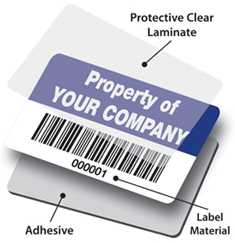Asset and Equipment Tracking
Keeping track of your assets
Registers, Barcodes, Data Codes and more...
With the increasing number of IT equipment, it's becoming more and more important to keep track of all your valuable assets.
Many businesses and organisations face significant challenges in asset tracking, including:
- location
- quantity
- condition
- maintenance status.
The most popular approach is to number each item with its own unique number or barcode, this helps you tell identical equipment apart quickly and easily.
Should you invest in Asset Registers?
The information for each numbered/coded item can be placed in an asset register.
Your asset register should contain details like:
- asset name
- description
- serial number
- replacement value/li>
- warranty
- other specifications such as service and maintenance schedules.
- location
- user

It is good practice to keep an asset register in case of fire or theft to prove ownership - indeed, it might even be a condition of your insurance cover - plus an asset label may also discourage "asset misappropriation", theft and fraud.
Asset Label Materials
Asset label materials range from cheaper vinyl through more durable materials such as aluminium foil and polyesters.
Always look for a quality material backed by the reputable supplier such as Dantech. to provide the best value.
Cheaper suppliers could prove more expensive in the long run as you may need to replace labels more frequently and find your assets are not protected as the labels are easily removed.
One special security material is ultra destructible or tamper evident vinyl. This material will break into small pieces if removal is attempted making obvious if someone has tampered with the label.
BARCODES - do we need them?
Barcodes are a machine-readable representation of alphanumeric data.
A letter is represented by bars and a scanner 'reads' these bars and the data can later be retrieved and entered into a spreadsheet or asset software program.
It saves time and reduces human error.
Go with a barcode label if you have lots of assets and need to track and check them quickly.
If your company only has a few assets, then barcoding is really unnecessary and a sequential numbering system will work.
Express labels use a symbology called Code 39 – or Code 3 of 9 – which is a widespread industry ‘standard’ because of its simplicity and versatility and can contain both letters and numbers.
Should you use Data Matrix Codes?
With the demand for more information, especially in the industry, to trace components/materials and their origin, a two-dimensional matrix code can be a better solution.
These codes can contain 100’s of digits/letters making them better than traditional barcodes that only hold 8-10 characters/digits. They are best used when a large amount of data is required.
Matrix codes are identified by a square or round data cell of black and white modules.
White modules are 0, and black modules are 1 (or vice versa, depending on the background material).
They have a large data capacity, high density, and automatic error correction, so even if partially damaged, they can still be read. They also offer omnidirectional scanning, i.e. operators no longer need to be concerned about the orientation making scanning and sorting faster.
Different from reading a conventional barcode with a line or laser reader, data matrix codes require a more complex solution and a two-dimensional picture is actually taken, which is then evaluated by the software algorithms.
Data Codes are great for detailed tracking in healthcare or industrial environments.
Find out more about Data Matrix Labels
Should you use QR Codes?
QR codes (quick response) are a quick method of accessing information about your company or products. They are also used for asset tracking and can contain a serial or asset number.
Although initially used to track parts in vehicle manufacturing, QR codes are now used over a much wider range of applications, including commercial tracking, entertainment, transport ticketing, product/loyalty marketing by using a QR code decoder which can be a mobile app.
Unlike one-dimensional barcodes, which were designed to be mechanically scanned by a narrow beam of light, a QR code is detected by a 2-dimensional digital image sensor.
The image is digitally analysed by a processor, which locates the three distinctive squares at the corners of the QR code image.
It uses a smaller square (or multiple squares) near the fourth corner to normalise the image for size, orientation, and angle of viewing.
The small dots throughout the QR code are then converted to binary numbers and validated with an error-correcting code.
Find out more about QR Code labels
For help and advice on selecting the right asset labelling solutions call Dantech on 01354 688488